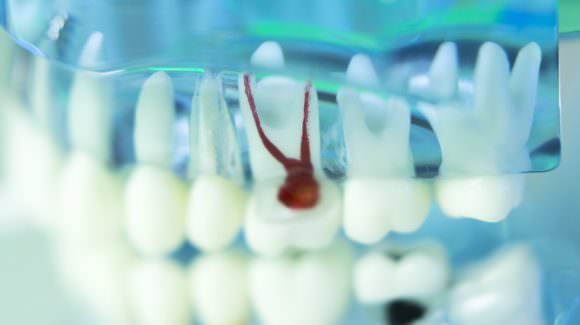
Teeth are living parts of the body. The outer part of the tooth is covered with a hard factor called “enamel’ but the core of the tooth is filled up with a soft substance – dentin, and inside there is a nerve and the vessel supplying blood to the tooth. Sometimes the nerve can become inflamed, leading to hypersensitivity, toothache or tooth abscess. Treatment of the root canals is especially necessary when the dental pulp is in an irreversible, advanced inflammation. This usually happens as a result of its infection by bacteria causing caries. Other causes of tooth nerve damage are also gum disease, mechanical injuries (accidents), as well as natural tooth wear being a result of abrasion or erosion.
Root canal treatment step by step
• diagnostics – the dentist decides to carry out the procedure based on the patient’s interview; in most cases RTG is taken as well,
• anesthesia – it is essential when the dental pulp is already inflamed but it has not died yet,
• preparation of the cavity – if the pulp infection is a result of caries, the dentist removes the diseased tissues, thus obtaining access to the tooth cavity,
• devitalization (tooth poisoning) – if the pulp has not died yet, it is necessary to intoxicate the tissue and the next stage of treatment occurs after 7-14 days (unless the root canal treatment is carried out during one visit, then the dentist immediately proceeds to remove pulp),
• removal of the pulp – the dentist removes the pulp from the tooth canals using small needle-like files,
• filling the canals – the pulp-free, disinfected and widened canals are filled with a special substance which becomes hardened over time,
• base and filling – after the root canals have been filled up the dentist applies the base – a layer separating the canals from the filling – and then the filling is performed.
After root canal treatment
Depending on the stage of infection, treatment may require several visits. Sometimes patients feel discomfort or even pain in the tooth after the root canal treatment for couple of months and sometimes the tooth may not calm down at all – then the treatment must be resumed. If the root canal treatment does not bring the expected results, it may be necessary to remove the tooth.
The patient should be aware that despite of the best treatment techniques available, success cannot be guaranteed, especially in case of the teeth with a very complex anatomy, however most of the root canal treatments are effective and they save patients from loosing their teeth.
Medical procedures after the root canal treatment
The root canal treatment needs to be followed by a special care for teeth that have been a subject to that as they are usually strongly weakened and therefore they require an additional protection with dental crowns or other technical solutions.
Because the teeth after the root canal treatment are already devitalised, they often take a darker shade, so it is worth to discuss some possible cosmetic procedures with the dentist.
Did you know that BUTTERFLY Dental Practice provides its services not only to the local Society of Oswestry but also to the inhabitants of the nearby cities and towns like Wrexham, Chester, Shrewsbury, Telford and Welshpool?


